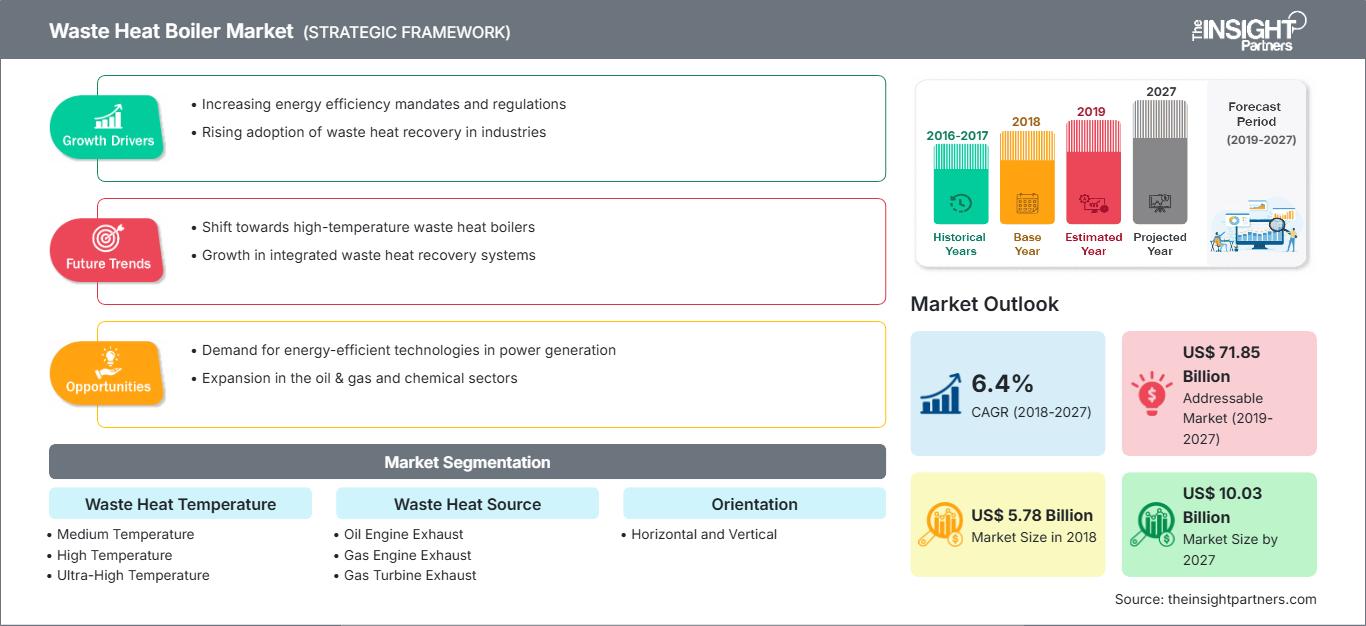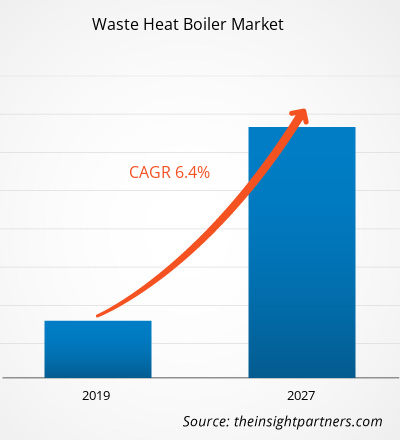[Research Report] The global waste heat boiler market is estimated to account US$ 5.78 Bn in 2018 and is expected to grow at a CAGR of 6.4% during the forecast period 2019 – 2027, to account to US$ 10.03 Bn by 2027.
The increasing focus towards the development of efficient energy solutions and various government programs for the implementation of the waste heat boiler is driving the waste heat boiler market. With increasing energy prices, industries are highly focused on implementing a waste heat recovery system. It is one the key area of research to reduce fuel consumption, improve production efficiency, and lower harmful emissions. Industrial waste heat is generated by industrial processes that do not have any practical use and are dumped into the environment. The Middle East & Africa waste boiler market is expeted to witness an CAGR growth rate of 6.7% from 2019 to 2027.
Waste Heat Boiler Market Insights
Attractve government initatives
Industrial waste heat is the energy generated in the core industrial processes of industries such as power generation utilities, oil & gas, chemicals, primary metals, non-metallic minerals, and others and these waste heat are conducted through various waste heat recovery technologies to provide valuable energy sources and reduce the overall energy consumption. According to the U.S. Department of energy, around 20% to 50% of industrial energy is reduced as waste heat in the form of exhaust gases. As the industrial sector continues its effort to enhance its energy efficiency, it would recover waste heat losses, reduces environmental impact, and enhances workflow and productivity. Various government initiatives are one of the key drivers for waste heat boiler market growth. The initiatives by various governments play an important role in successful waste heat boilers implementation, which would further increase the demand for waste heat boiler market. Thus, driving the growth of the waste heat boiler market during the coming years.
Customize This Report To Suit Your Requirement
You will get customization on any report - free of charge - including parts of this report, or country-level analysis, Excel Data pack, as well as avail great offers and discounts for start-ups & universities
Waste Heat Boiler Market: Strategic Insights

-
Get Top Key Market Trends of this report.This FREE sample will include data analysis, ranging from market trends to estimates and forecasts.
Surge in adotion of energy efficient solutions
In the future, the energy-efficient solutions would most likely to witness high demand. Waste heat boiler, an energy-efficient equipment are used to recover waste heat energy and can reduce future operating costs, capital investment, and utility systems costs. The performance of waste heater boilers is a key element in the efforts of commercial facilities to hold down utility costs. For maintenance and engineering procedures in various industries, businesses trying to provide efficient boiler performance, the efficiency of the boiler is decided by the proportion of heat output to the amount of fuel utilized. According to the U.S Department of energy, traditional heating systems generally run between 56% to 70% efficiency, which is a substantial loss in energy savings. However, modern boilers and water heaters run around 80% efficiency, which provides significant energy savings when used in a number of industries. Thus, developing technologies offer promise in recovering waste heat more efficiently rather than traditional.
Waste Heat Boiler Market – Waste Heat Temperature Segment Insights
Depending on the process type, waste heat can be released at nearly any temperature in an industrial furnace or kiln. Typically most of the waste heat generated in the high temperature originates from direct combustion processes; heat generated in the medium range comes from the exhaust of combustion units; and heat generated in the low temperature range comes from products, parts, and the process unit equipment. The power generating efficiency from waste heat recovery is greatly reliant on the waste heat source temperature. Generally, economically viable waste heat power generation has been restricted chiefly to medium- to high-temperature or ultra-high waste heat sources.
Waste Heat Boiler Market – Waste Heat Source Segment Insights
Energy intensive processes in industries, including processes occurring at steel mills, refineries, glass furnaces, and cement kilns, releases hot exhaust gases as well as waste streams which are capable to be harnessed with heat recovery technologies, such as waste heat boiler, to generate electricity. The exhaust flue gases, after being released from the furnace, holds a considerable amount of thermal energy. In several fuel-fired heating systems, the waste heat is the ultimate source of heat loss in the process, often exceeding all the other losses combined. Depending upon the type of process and equipment, the source of waste heat is categorized into oil engine exhaust, gas engine exhaust, gas turbine exhaust, incinerator exit gases, kiln & furnace gases, and others.
Waste Heat Boiler Market – Orientation Segment Insights
The waste heat boiler market by orientation is segmented into horizontal and vertical boilers. The waste heat recovery capacity of each of these boilers depends on the boiler efficiency. Further, the choice of orientation is majorly dependent on the installation site. Vertical boilers are usually preferred at small and narrow application, however horizontal boilers are mostly deployed at spacious site. Both of these boilers are different in terms of application area, thus the choice completely depends on the customers’ requirements.
Waste Heat Boiler Market – End-user Segment Insights
A considerable energy amount used by different industries is wasted as heat leaving industrial facilities. These include air streams, exhaust gases, and liquids. Though it is not economically and technically viable to recuperate all waste heat, a certain amount of this heat can be recovered through various heat recovery procedures. According to a study, waste-heat recovery can substitute around 9% of the total energy used by industries in the US, which would eventually help enhance the US global competitiveness. It would further help to mitigate emissions of greenhouse gases. The potential for waste-heat recovery opportunities differs widely from industry to industry. The primary metal is expected to be major market driver for end-user in the waste heat boiler market.
Some of the market initiatives were observed to be most adopted strategy in the global waste heat boiler market. Few of the recent market initiatives adopted by the market players operating in the waste heat recovery boiler market are listed below:
2019:Thyssenkrupp Industries India announced that it entered into an agreement with Gainwell, which is a leading distributor of mining, construction, and power solutions. This pact would help the company to strengthen its position in the Indian Market.
2018:Robert Bosch announced the inauguration of its new R&D center in Suzhou, China. This new R&D center employs around 1,500 associates and focuses majorly on the manufacturing of mobility as well as connected solutions.
2018:Thermax won Rs. 340 Cr order from an Indian steel major. The order consists of a specially designed boiler, electric turbo generators and ancillary equipment for the production facility. The steam boiler would utilize waste gases produced in steel manufacturing to generate high-pressure steam for power generation.
The regional trends and factors influencing the Waste Heat Boiler Market throughout the forecast period have been thoroughly explained by the analysts at The Insight Partners. This section also discusses Waste Heat Boiler Market segments and geography across North America, Europe, Asia Pacific, Middle East and Africa, and South and Central America.
Waste Heat Boiler Market Report Scope
| Report Attribute | Details |
|---|---|
| Market size in 2018 | US$ 5.78 Billion |
| Market Size by 2027 | US$ 10.03 Billion |
| Global CAGR (2018 - 2027) | 6.4% |
| Historical Data | 2016-2017 |
| Forecast period | 2019-2027 |
| Segments Covered |
By Waste Heat Temperature
|
| Regions and Countries Covered |
North America
|
| Market leaders and key company profiles |
|
Waste Heat Boiler Market Players Density: Understanding Its Impact on Business Dynamics
The Waste Heat Boiler Market is growing rapidly, driven by increasing end-user demand due to factors such as evolving consumer preferences, technological advancements, and greater awareness of the product's benefits. As demand rises, businesses are expanding their offerings, innovating to meet consumer needs, and capitalizing on emerging trends, which further fuels market growth.

- Get the Waste Heat Boiler Market top key players overview
GLOBAL WASTE HEAT BOILER MARKET SEGMENTATION
Global Waste Heat Boiler Market – By Waste Heat Temperature
- Medium Temperature
- High Temperature
- Ultra-High Temperature
Global Waste Heat Boiler Market – By Waste Heat Source
- Oil Engine Exhaust
- Gas Engine Exhaust
- Gas Turbine Exhaust
- Incinerator Exit Gases
- Kiln & Furnace Gases
- Others
Global Waste Heat Boiler Market – By Orientation
- Horizontal
- Vertical
Global Waste Heat Boiler Market – By End-user
- Power Generation Utilities
- Oil & Gas
- Chemical
- Primary Metals
- Non-Metallic Minerals
- Others
Global Waste Heat Boiler Market – By Geography
-
North America
- U.S.
- Canada
- Mexico
-
Europe
- France
- Germany
- Italy
- UK
- Rest of Europe
-
Asia Pacific (APAC)
- China
- India
- Japan
- Australia
- South Korea
- Rest of APAC
-
Middle EAST & Africa (MEA)
- Saudi Arabia
- UAE
- South Africa
- Rest of Middle East & Africa
-
South America
- Brazil
- Rest of South America
Global Waste Heat Boiler Market - Company Profiles
- Alfa Laval
- CiTECH Energy Recovery Solutions (UK) LTD
- General Electric
- Kawasaki Heavy Industries, Ltd.
- Nooter/Eriksen
- The Bosch Group
- Thermax Limited
- Thyssenkrupp AG
- Viessmann Group
- Zhengzhou Boiler Co., Ltd
- Historical Analysis (2 Years), Base Year, Forecast (7 Years) with CAGR
- PEST and SWOT Analysis
- Market Size Value / Volume - Global, Regional, Country
- Industry and Competitive Landscape
- Excel Dataset
Recent Reports
Related Reports
Testimonials
Reason to Buy
- Informed Decision-Making
- Understanding Market Dynamics
- Competitive Analysis
- Identifying Emerging Markets
- Customer Insights
- Market Forecasts
- Risk Mitigation
- Boosting Operational Efficiency
- Strategic Planning
- Investment Justification
- Tracking Industry Innovations
- Aligning with Regulatory Trends





















 Get Free Sample For
Get Free Sample For